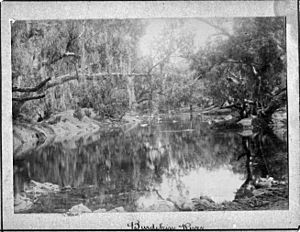Irwin's turtle facts for kids
Quick facts for kids Irwin's turtle |
|
|---|---|
 |
|
| Scientific classification | |
| Genus: |
Elseya
|
| Species: |
irwini
|
Irwin's turtle (Elseya irwini) is a rare species of freshwater turtle in the family Chelidae. The species is endemic to Australia, originating from the lower region of the Burdekin River area.
Discovery
Steve Irwin and his father Bob Irwin, spotted a specimen of E. irwini on a crocodile catching trip on the Burdekin river in 1990. They had never seen it before. "Co-discoverer", famed zoologist and TV personality, Steve Irwin took pictures and sent them to turtle-expert John Cann who verified that it was indeed a new species. This new species was then named after the father and son duo.
Description
The female of the species E. irwini has a pale head with a yellowish horny sheath on the crown. The pale color present in the female of this species is due to a lack of multiple pigments which affect essentially all parts of the body. These individuals are known for their sturdy skull, which is supported by a narrow muscle called the pterygoid, creating a shielding for the skull and providing normal jaw functions.
Respiration
E. irwini, like some other turtles, can breathe underwater by taking water into its cloaca. The cloaca is a cavity at the end of the digestive tract containing a chamber with gill-like structures which allow for the diffusion of oxygen . Without this structure, this species of turtle would not be able to stay under water for long periods of time. Irwin's turtle needs to live in a source of water that is plentiful with oxygen. If the water has low oxygen levels or is filled with contaminants, the turtle has a lower chance of survival.
Threats to Irwin's Turtle
The habitat of the Irwin's Turtle has been impacted by the construction of the Burdekin Dam, which has caused a decline in water quality of the Burdekin River. Poor water quality makes it hard for this species to survive and reproduce. Plans for the construction of Urannah Dam would cause further impacts and habitat contraction.
Images for kids



